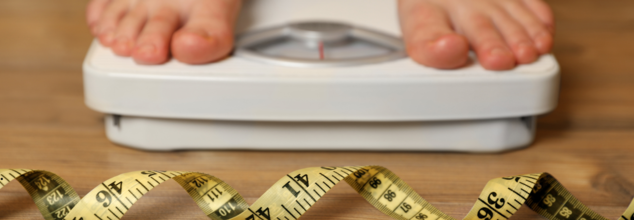- Health Conditions A-Z
- Health & Wellness
- Nutrition
- Fitness
- Health News
- Ayurveda
- Videos
- Medicine A-Z
- Parenting
Is It Time To Say Goodbye To BMI?

Credits: Canva
For decades we were made to believe that the go-to measure for assessing a person's healthy weight was BMI or Body Mass Index. Whether it is a routine doctor's appointment or your first day in the gym, BMI is calculated to judge your health. Many companies, including protein companies, have also incentivised by the buzzing word BMI. However, many recent studies suggest that BMI may no longer be the best indicator of health and BRI might be the new BMI.
BRI Is The New BMI
Many scientists are now looking at a new way to calculate obesity, this is called the Body Roundness Index or the BRI. It is said to be more accurate than BMI.
In a study published in JAMA Network Open, researchers found that a higher BRI was associated with an increased risk of death from any cause. The authors of this study concluded that BRI is a tool that is as easy as BMI to perform and calculate, however, it offers a more accurate assessment of body composition.
“Our findings provide compelling evidence for the application of BRI as a noninvasive and easy to obtain screening tool for estimation of mortality risk and identification of high-risk individuals, a novel concept that could be incorporated into public health practice pending consistent validation in other independent studies,” the authors wrote.
What Exactly is BRI?
BRI was first proposed in 2013, it uses height, weight, waist circumference and sometimes hip circumference for its calculation. The initial paper that detailed the concept of BRI was authored by Diana M Thomas, PhD, a professor of mathematics at the United States Military Academy at West Point said that it uses the concept of eccentricity, which describes how round or narrow something is. It represents a number between zero, for a perfect circle and one.
"With BMI you’re actually using just two measurements. You’re using weight and height. In the Body Roundness Index, we’re using a few more measurements on the human body to capture that shape,” said Thomas.
Limitations of BMI
BMI is calculated by dividing one's weight in kilograms by the square of their height in meters. It has been used for years to categories weight into underweight, normal overweight, and obese.
A BMI between 18.5 and 24.9 is considered normal, while a BMI over 30 is classified as obese. However many experts have raised objections with it being the measurement unit. One of the major limitations is that it does not account for body composition. It does not tell anyone anything about the proportion of muscle, fat, or water in the body. For instance, athletes with high muscle mass may have a higher BMI, but they are fit and healthy.
It also does not tell us where the fat is stored in the body.
Whereas BRI calculates the percentage of body fat and provides a visual representation of the body's shape. A score between 1 to 15 is assigned, with scores over 6.9 or under 3.41 is considered to be at the higher risk of illness.
Doctors Say This One Symptom Separates Covid From Seasonal Illness

A GP has raised concern about a key sign that may show you have Covid rather than a cold or flu. Winter illnesses often look alike, which makes it hard to tell them apart, and getting the right diagnosis is important for proper care. Dr Rupa Parmar, GP and medical director at Midland Health, explained that there are certain clues that can help people understand what they are dealing with. She advised that anyone unsure should check with their doctor, as it is safer to ask than ignore a concern.
Why Breathlessness Matters
Dr Parmar noted that shortness of breath stands out as a sign of Covid. It rarely appears in a cold or flu, but it is common with Covid because the infection tends to affect the lungs and cause inflammation. The NHS also lists breathlessness as a sign linked more strongly with Covid than with flu or a cold. This symptom is also seen in conditions such as respiratory syncytial virus. In some cases, people with the flu who do not recover and worsen may develop breathing trouble if they develop complications such as pneumonia.
How Cough Patterns Differ
She added that coughs appear in all three infections, but they do not sound the same. A cold usually causes a light cough, flu tends to bring a dry one, and Covid usually causes a dry, ongoing cough. Many people with Covid cough for more than an hour or have several episodes of coughing through the day.
Loss Of Taste Or Smell As A Warning Sign
Another clue is a change in taste or smell. Dr Parmar said this sign is more specific to Covid. A sudden loss of taste or smell, or even a noticeable change, is more likely linked to the coronavirus. She explained that the pattern of symptoms often helps point to the right illness. A mild cough and sore throat usually fit a cold, a fever and strong fatigue suggest flu, and a loss of smell or taste with a steady cough point to Covid.
How Symptoms Begin And Progress
She also noted that the start of symptoms can differ. A cold tends to appear slowly, flu symptoms usually show up quickly within a few hours, and Covid can begin with mild signs that grow stronger over time. A cold mainly affects the nose and throat, while flu and Covid can cause symptoms across the body.
What To Do If You Have Covid Symptoms
Even though there are no formal self-isolation rules anymore, the NHS advises people to stay home and limit contact with others if they or their children have symptoms and either have a high temperature or feel too unwell to manage daily activities at work, school, or home. The NHS states that people can return to their usual routine once they feel well again or no longer have a high temperature.
Feeling Low All The Time? Doctors Say A Common Deficiency May Be The Cause

Credits: Canva
As winter settles in, many people sense a shift in their mood. Shorter days and colder weather often leave us feeling a little dull. In some cases, this may be linked to seasonal affective disorder (SAD). Yet there may also be another explanation.
A doctor has cautioned that a very common deficiency could be the reason you have been feeling unusually low. He noted that this problem affects well over a billion people around the world.
Iron Deficiency Might Be The Reason Behind Your Low Mood
In a TikTok video, Doctor Sermed Mezher raised concern about iron deficiency. Iron is a mineral the body relies on to move oxygen through the blood and support several important processes. Dr Mezher explained as per Express, “Low iron is the most common nutritional deficiency in the world, affecting more than one billion people.” He also described how it can influence dopamine, often referred to as the “feel-good” chemical.
He added, “And its effects on dopamine go way deeper than just oxygen transport. Dopamine is made from an amino acid called tyrosine over a couple of steps, and the enzyme involved in the first step needs iron to work properly. It is no surprise, then, that in iron deficiency, studies show problems in dopamine pathways that play a part in happiness, reward, self control and social behaviour.”
The positive news is that this can usually be managed. Dr Mezher said, “Once your iron levels are restored, these pathways return to their normal state, and you can help this process by taking iron with vitamin C and staying away from caffeinated drinks for two hours before and after.”
Symptoms Of Iron Deficiency
The NHS lists several signs of iron deficiency anaemia, including:
- Tiredness and low energy
- Shortness of breath
- Heart palpitations
- Paler skin
- Headaches
If you think you may be low in iron, you should talk to your GP. A simple blood test can confirm it.
How To Boost Iron Levels?
Iron levels can be raised through the foods you eat. These options are naturally rich in iron:
- Dark-green vegetables such as watercress and curly kale
- Iron-fortified cereals and bread
- Meat
- Dried fruits like apricots, prunes and raisins
- Pulses including beans, peas and lentils
The NHS also suggests cutting back on:
- Tea
- Coffee
- Milk and dairy products
- Foods high in phytic acid, like wholegrain cereals, which can prevent your body from absorbing iron from meals and supplements
The NHS notes, “Large amounts of these foods and drinks make it harder for your body to absorb iron. You might be referred to a specialist dietitian if you're finding it hard to include iron in your diet.”
How Much Iron Does One Need?
The daily iron requirement is:
- 8.7mg for men aged 19 and above
- 14.8mg for women aged 19 to 49
- 8.7mg for women aged 50 and above
The NHS adds, “Taking 17mg or less a day of iron supplements is unlikely to cause any harm. But continue taking a higher dose if advised to by a GP.”
Ozempic Users In 2025 Reported These 5 Unusual Side Effects

Credits: Canva
From celebrities trying to slim down for a red-carpet event to people using medication to manage diabetes or obesity, GLP-1 drugs have become a widely used choice for weight control. They are often described as near-perfect solutions, yet they can bring unexpected effects. In 2025, many users began noticing reactions that had not been mentioned before, especially among those taking Ozempic. If you rely on Ozempic for weight management or overall health, it helps to know the unusual side effects people spoke about during the year.
What are GLP-1 Drugs?
GLP-1 drugs, also known as GLP-1 agonists, were first developed for diabetes care. They work much like the body’s own GLP-1 hormone, which is released after meals to prompt insulin production. Those living with diabetes often do not make enough insulin to keep blood sugar steady. A GLP-1 medication boosts insulin release so blood sugar stays more stable. These drugs often support weight reduction as well.
For many people with diabetes, weight control plays an important role in managing the condition. GLP-1 drugs reduce hunger and help the stomach empty more slowly, creating a longer sense of fullness. This can lead to marked weight loss in people with or without diabetes.
Ozempic: What Is It And How Does It Work?
Ozempic is a prescribed treatment mainly used for adults with type 2 diabetes. The active substance is semaglutide, given once a week through an injection. It is a glucagon-like peptide-1 (GLP-1) receptor agonist that acts like a natural hormone in the body. It increases insulin when blood sugar rises, lowers glucagon levels, and slows the movement of food through the stomach, which in turn reduces appetite.
5 Unusual Side Effects Of Ozempic People Reported In 2025
Beyond the familiar effects such as nausea, constipation, and stomach discomfort, some users shared experiences that felt different from the typical list. Below are the unusual reactions connected with Ozempic that gained attention in 2025.
Ozempic Vulva
“Ozempic vulva” is a phrase women have used to describe changes in the vulva, including loss of volume, sagging, or dryness, especially after major weight loss linked to Ozempic or similar medicines. These changes are not a medical diagnosis. They seem to come from rapid fat loss, reduced muscle mass, shifts in hormones, or dehydration, rather than the drug itself, according to Healthline. Reported changes include a less plump appearance in the labia majora, dryness, and a looser texture.
Ozempic Poop
Medical News Today notes that Ozempic often triggers what is known as a “stool reflex”, in which the gut tries to clear space once food reaches the intestine. In some people, this reflex becomes unusually strong, leading to diarrhea. Many users have discussed this on Reddit. One person created a widely shared thread asking, with complete honesty, for tips on avoiding accidents while sleeping. They explained they had struggled with this for months and called it their most frustrating symptom. Another user, after three doses, said that “sh*tt*ng the bed” was the one thing they were dreading.
The good news is that most people do not face such long-lasting trouble. Studies from 2022 show that diarrhea linked with Ozempic usually lasts around three days when starting the drug. For most users, it settles within about four weeks as the body adapts.
Ozempic Breasts
“Ozempic breasts” is an informal expression used for changes in breast size or shape that appear after rapid weight loss while on Ozempic. Breasts contain a large amount of fatty tissue, so when someone loses weight quickly, they may notice less fullness, sagging, or a flatter look. Although this is not a recognised medical term, it has become a common concern among those using the medication, according to Healthline.
Ozempic Butt
“Ozempic butt” refers to loose or sagging skin that may show up after dramatic and fast weight loss while using these drugs. This can cause a softer or deflated look in areas where people naturally hold more weight. It is important to remember that this effect comes from rapid weight loss and not from the medication acting directly on the body.
Ozempic Feet
“Ozempic feet” is a name people have given to changes in the feet linked with sudden weight loss from drugs like Ozempic. These include loose skin, reduced fat padding, more visible veins, and extra pain while walking. These shifts can make the feet more sensitive and increase the chance of developing corns and calluses, since there is less cushioning. Other possible concerns include tingling, numbness, or swelling, as noted by Healthline.
If you notice any of these changes, remember that they often appear during periods of fast weight loss. Still, it is best to speak with your healthcare professional if anything becomes difficult to manage or feels out of the ordinary.
© 2024 Bennett, Coleman & Company Limited

